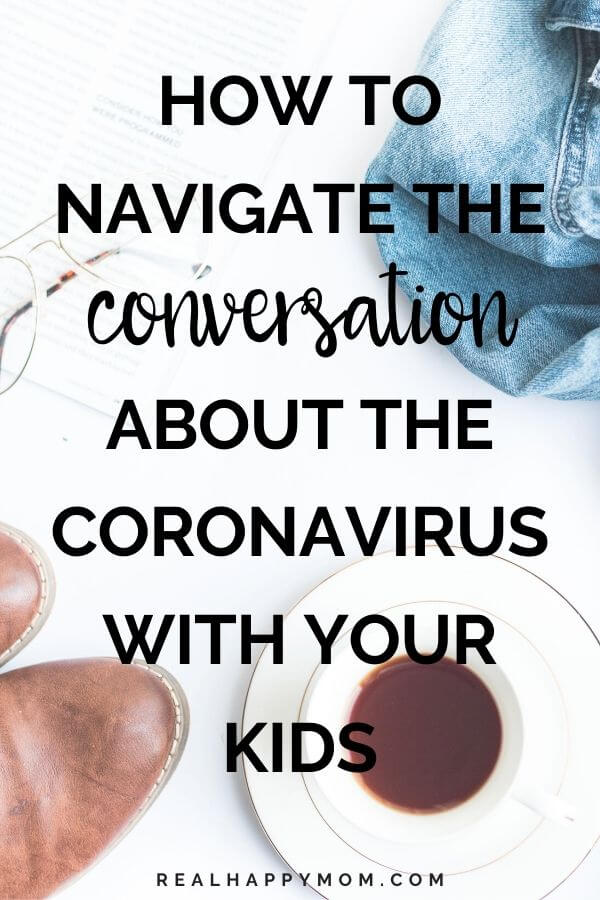LISTEN: APPLE PODCASTS | SPOTIFY | STITCHER
Having difficult conversations with kids is always one that I try to avoid.
The problem is this serves no one. Kids are still left with questions that they may resort to their friends or the internet to answer.
The coronavirus is no different.
Instead of avoiding the conservations and worrying about how much information you should share, welcome the conversation.
But before you do, check out the episode with Dr. Jennifer Variste above or the blog post below to get you prepared.

Before you have a conversation with your kids, do this.
Before you initiate the conversation about the coronavirus, you first need to have a talk with yourself.
When you have that conversation with yourself first, make sure that you calm yourself down.
Don’t talk to your kids from an anxious state or a state of worry. Your kids need your reassurance.
If you’re in a troubled state when you talk to your child, they will be able to see right through whatever you are saying.
And it won’t be as effective at reassuring your child. Take some time to manage your own anxiety first.
Ways to start the conversation about coronavirus
When you’re ready to initiate the conversation with your child, you want your child to feel comfortable talking to you and asking you questions.
You could open the conversation with, “do you have any questions about what’s going on with the coronavirus?”
Another way to bring up the conversation is to say, “We can’t have our playdates with Billy anymore, but you can have a virtual play date with him. When would you like to set that up?”
You let your child know about the restriction. But you immediately follow that restriction with what they can do.
This empowers your child by giving them some autonomy by choosing when they do it.
Another way to start the conversation is by talking about the importance of handwashing.
Explaining how we can prevent the spread of the virus by washing our hands. You could say. “This virus is easily beaten and prevented if we wash your hands with soap and water. So let’s do that. Let’s wash your hands and sing the birthday song.”
Whenever you find your child washing their hands, covering their mouth when they sneeze or cough, or throwing away their used tissue, don’t forget to praise them and encourage them.
All of those things are ways to emphasize how this isn’t a hopeless situation.
For older kids, they may need a little time to process what’s going on and how they feel about everything.
Your child withdrawing is not uncommon, because they are trying to figure things out and formulate their own opinions.
You can help empower them by giving them space and time to process everything.
If their behavior is not harmful or destructive and it’s not disrespectful, provide them with that space and just let them know that whenever they’re ready to talk, you’re always there.

Be a fact-checker
Let’s be real.
Your tweens and teens are not just hearing things from the news.
But they’re also hearing things from their friends and social media. Those are the last places that we want our kids to get reliable information.
We want to be the fact-checker as the parent. Because kids are going to hear things that are not true or inaccurate.
So as the fact-checker, you will help to identify the truth and dispel the lies that may be causing your child to be anxious unnecessarily.
One way to be a fact-checker is by going on reputable websites like:
- American Academy of Pediatrics
- HealthyChildren.org
- The World Health Organization
- Your local Health Department
If your child is exposed to the conspiracy theories, it’s essential to ground your child, empower your child, and remind them what they really need to focus their energy on.
We definitely don’t want to dismiss it. But we always want to refocus our kids on what’s important. Because if we chase after every conspiracy out there, it really creates a feeling of hopelessness and increases anxiety.
I just coughed, and now my child thinks I have the coronavirus. What should I say?
As parents, we’re continually having to humble ourselves. Our kids will call us out in every situation.
If you cough or sneeze and your child tells you that you have the coronavirus (like my 7-year-old did), this is a great teachable moment.
First, a child must understand that literally, anyone outside the home could have coronavirus.
That’s the kind of way that we want to approach the coronavirus at this point, even if they don’t have symptoms, because most places are having community spread now and so you don’t necessarily have to be exposed to someone who had it to catch it now.
We have to take time to explain things like social distancing, maintaining that six feet apart from someone, or even addressing the issue of the mask.
If we come from a mindset where we just assume that everybody has it, that will make more sense of the child. So we don’t want to present conflicting messages.
Secondly, reinforcing to your child that usually the most common symptoms of the coronavirus have been fever and cough. Still, again, there have been cases where they don’t present classically, and they’re positive.
An appropriate response to a child’s concerning statement could be, “You know what? That’s why it’s always so important to cover your mouth when you cough or sneeze. If you don’t have a tissue, do it into the elbow, and you always want to wash your hands. And so that’s why mom is washing your hands right now.”

The difference between self-isolation, quarantine, social distancing
When it comes to having a conversation with your child about why you’re still going to work when the virus is still out there, it’s crucial to understand the difference between the following terms: self-isolation, quarantine, social distancing.
Self-isolation
Self-isolation and quarantine both involve no access to the public. This means not going outside a house.
Self-isolation is recommended when someone is starting to develop symptoms of the coronavirus.
To reduce the spread of the coronavirus, you’re self-isolating yourself away from the public.
And ideally away from the other individuals in the household.
Quarantine
Quarantine, at this time, is reserved specifically for people who may have been in contact or exposed to someone with the coronavirus.
If someone was tested positive for the coronavirus, they would quarantine themselves, which means no access to the public, not leaving the house for at least 14 days.
Also, watching to see if any symptoms developed.
Social distancing
The whole point of social distancing is to reduce transmission of the virus.
Social distancing involves maintaining six feet between you and another individual.
It also means washing your hands, disinfecting surfaces, covering your mouth when you cough.
The CDC and other individuals are recommending wearing a mask when you’re outside.
Most places in the United States now have a community spread, and so it’s prudent to comply to prevent the spread of the virus.

What to say when you are going to work
When explaining why you are going to work during the pandemic to your child, your child must understand that there are vital businesses that must stay open to keep the country moving.
Just because you have to go to work doesn’t mean that you are not protected.
You can reassure your child that you are practicing social distancing, wearing a mask, and washing your hands.
Tips for finding a pediatrician during a pandemic
Even during this pandemic, you still want to make sure that you can get along with your pediatrician.
This is why it’s essential to take your time to find a pediatrician. But what are some things to look for when finding a pediatrician?
Some pediatricians are allowing moms to do that prenatal visit via telemedicine.
This is a video call that you can do in the comfort of your own home.
But it’s essential to have a conversation with the pediatrician to see if you guys get along. Your pediatrician is going to be your expert best friend.
So your pediatrician must be one that you feel comfortable with. You will lean on your pediatrician for advice throughout your child’s life.
Plus, you want to be able to trust your pediatrician.
For the big kids
If your child is older and you need a new pediatrician here are a few questions to ask:
- What changes has the office implemented in light of the pandemic?
- How is the office separating the sick kids from the well kids?
- What protective measures are the individuals in the office taking as far as protective gear?
- What are some steps that have been put in place during this pandemic?
Hopefully, these tips have helped you feel better prepared to have a conversation with your child. Many times we underestimate how much our kids know and understand.
If you still need some help, drop your questions in the comments below.

About Jennifer
As a board-certified pediatrician, Dr. Variste’s passion is to empower moms and dads to raise their kids to lead happy, healthy lives full of precious memories and discovery.
She desires to create the same positive experiences for her patients that she had with her pediatrician as a young child.

Time stamp
00:50 – Mommy Win with @whydidntanyonetellme
02:31 – About Jennifer
03:44 – Having the conversation about coronavirus
16:00 – The difference between self-isolation, quarantine, social distancing
20:48 – Tips for finding a pediatrician during the pandemic
Links mentioned in this episode.
- American Academy of Pediatrics
- HealthyChildren.org
- The World Health Organization
- Houston Emergency
- Family First Pediatrics
- Facebook Page – Jennifer Variste MD
- Instagram @jvpediatrics
- Facebook group – Neighborly Moms with an Expert Best Friend
Check out the other episodes in the COVID-19 series.
- Managing Stress During Uncertain Times
- Practical Tips for Parenting When You Are Stressed and Overwhelmed
- How to Navigate the Conversation About Coronavirus with Your Kids
Subscribe & Review in iTunes
Have you subscribed to the Real Happy Mom podcast? If not, I’m encouraging you to do it today.
I don’t want you to miss any upcoming episodes. I am planning on adding some bonus episodes that you won’t find on this website, and if you’re not subscribed, you might miss out on those. Click here to subscribe in iTunes!
I would be so happy and grateful if you left me a review on iTunes too. Reviews help iTunes to know that this is a podcast for other moms so that other moms can find this podcast. Plus, it makes my day to read the reviews.
Just click here to review, select “Ratings and Reviews” and “Write a Review” and let me know what your favorite part of the podcast is. Thanks in advance!
Don’t have iTunes? You can subscribe to the podcast Google Podcast, Anchor, Spotify, Breaker, Castbox, Overcast, RadioPublic, and Stitcher.
Related blog post
Check out the other episodes in the COVID-19 series.
- Managing Stress During Uncertain Times
- Practical Tips for Parenting When You Are Stressed and Overwhelmed
- How to Navigate the Conversation About Coronavirus with Your Kids
- Self-Care to Help Save Your Sanity During a Pandemic
- Tips for Managing Your Money During Hard Times
Featured Mom Win
This week’s mom win comes from Hannah @whydidntanyonetellme
If you want to share your mommy win and be featured on the podcast, go to Instagram and follow me @realhappymom. Then go to the DMs and say, hey. Press and hold the microphone button on the lower right-hand side of the screen, then tell me your name, IG handle, tell us what you do and how you are winning. Anything big or small is welcome, we want to celebrate with you.
Leave me a message about this episode

[…] How to Navigate the Conversation About Coronavirus with Your Kids […]